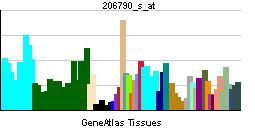Entrez 4707 | Ensembl ENSG00000183648 | |
 | ||
Aliases NDUFB1, CI-MNLL, CI-SGDH, MNLL, NADH:ubiquinone oxidoreductase subunit B1 External IDs HomoloGene: 129534 GeneCards: NDUFB1 | ||
NADH dehydrogenase [ubiquinone] 1 beta subcomplex subunit 1 is an enzyme that in humans is encoded by the NDUFB1 gene. NADH dehydrogenase (ubiquinone) 1 beta subcomplex, 1, 7kDa is an accessory subunit of the NADH dehydrogenase (ubiquinone) complex, located in the mitochondrial inner membrane. It is also known as Complex I and is the largest of the five complexes of the electron transport chain.
Contents
Structure
The NDUFB1 gene, located on the q arm of chromosome 14 in position 32.12, is 5,687 base pairs long. The NDUFB1 protein weighs 7 kDa and is composed of 105 amino acids. NDUFB1 is a subunit of the enzyme NADH dehydrogenase (ubiquinone), the largest of the respiratory complexes. The structure is L-shaped with a long, hydrophobic transmembrane domain and a hydrophilic domain for the peripheral arm that includes all the known redox centers and the NADH binding site. NDUFB1 is one of about 31 hydrophobic subunits that form the transmembrane region of Complex I. It has been noted that the N-terminal hydrophobic domain has the potential to be folded into an alpha helix spanning the inner mitochondrial membrane with a C-terminal hydrophilic domain interacting with globular subunits of Complex I. The highly conserved two-domain structure suggests that this feature is critical for the protein function and that the hydrophobic domain acts as an anchor for the NADH dehydrogenase (ubiquinone) complex at the inner mitochondrial membrane.
Function
The human NDUFB1 gene codes for a subunit of Complex I of the respiratory chain, which transfers electrons from NADH to ubiquinone. However, NDUFB1 is an accessory subunit of the complex that is believed not to be involved in catalysis. Initially, NADH binds to Complex I and transfers two electrons to the isoalloxazine ring of the flavin mononucleotide (FMN) prosthetic arm to form FMNH2. The electrons are transferred through a series of iron-sulfur (Fe-S) clusters in the prosthetic arm and finally to coenzyme Q10 (CoQ), which is reduced to ubiquinol (CoQH2). The flow of electrons changes the redox state of the protein, resulting in a conformational change and pK shift of the ionizable side chain, which pumps four hydrogen ions out of the mitochondrial matrix.
